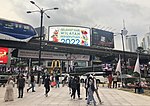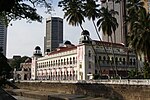Kuala Lumpur (Malaysian pronunciation: [ˈkualə, -a ˈlumpo(r), -ʊ(r)]), officially the Federal Territory of Kuala Lumpur (Malay: Wilayah Persekutuan Kuala Lumpur) and colloquially referred to as KL, is a federal territory and the capital city of Malaysia. It is the largest city in Malaysia, covering an area of 243 km2 (94 sq mi) with an census population of 1,982,112 as of 2020. Greater Kuala Lumpur, also known as the Klang Valley, is an urban agglomeration of 7.564 million people as of 2018. It is among the fastest growing metropolitan regions in Southeast Asia, both in population and economic development.
The city serves as the cultural, financial, and economic centre of Malaysia. It is also home to the Parliament of Malaysia, and the Istana Negara, the official residence of the Yang di-Pertuan Agong (monarch of Malaysia). Kuala Lumpur first developed around 1857 as a town serving the tin mines of the region and served as the capital of Selangor from 1880 until 1978. Kuala Lumpur was the founding capital of the Federation of Malaya and its successor Malaysia, and the city remained the seat of the executive and judicial branches of the Malaysian federal government until these were relocated to Putrajaya in early 1999. However, some sections of the political bodies still remain in Kuala Lumpur.
Kuala Lumpur is one of the three federal territories of Malaysia, enclaved within the state of Selangor, on the central west coast of Peninsular Malaysia. Since the 1990s, the city has played host to many international sporting, political and cultural events including the 1998 Commonwealth Games and the 2017 Southeast Asian Games. Kuala Lumpur has undergone rapid development in recent decades and is home to the tallest twin buildings in the world, the Petronas Towers, which have since become an iconic symbol of Malaysian development.
It has a comprehensive road system supported by an extensive range of public transport networks, such as mass rapid transit (MRT), light rapid transit (LRT), monorail, commuter rail, public buses, hop on & hop off buses (free of charge) and airport rail links. Kuala Lumpur is one of the leading cities in the world for tourism and shopping, the 6th most-visited city in the world in 2019. The city houses three of the world's ten largest shopping malls.Kuala Lumpur ranks 70th in the world and second in Southeast Asia for Economist Intelligence Unit's Global Liveability Ranking and ninth in ASPAC and second in Southeast Asia for KPMG's Leading Technology Innovation Hub 2021. Kuala Lumpur was named World Book Capital 2020 by UNESCO.









